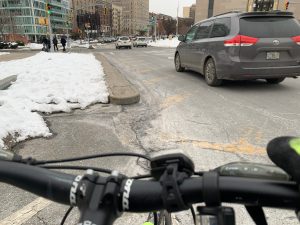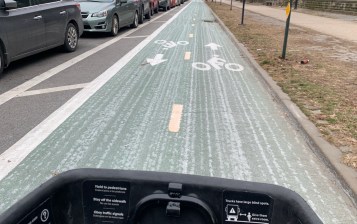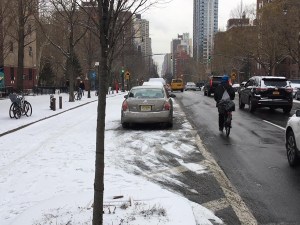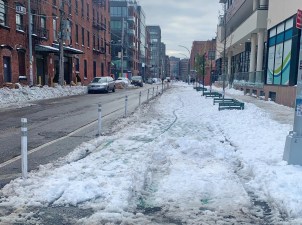Walking After a Snow Storm Wasn’t Always This Icy and Dicy

After a series of snow storms, this week has been a tough one for walking in New York City. Deep oceans of slush pool at corners where snow and ice block storm drains. Many property owners, including the city government, have failed to shovel their walks as the law requires. Long stretches of sidewalk are bumpy stretches of hard, slick compacted snow and ice. Bus stops? Fuggedaboutit.
Thanks to the city’s plow fleet, if you want to drive across town, the worst thing you might encounter is shoveling out your vehicle from its free on-street parking spot. Now that the storm has passed, spinning out on a snowy road isn’t much of a problem. But walking is a different story this week.
The indignity of walking after the storm is distilled in this video showing a man on the sidewalk of Coney Island Avenue in Brighton Beach early Wednesday morning. The walk remains covered in snow, but the car lanes appear to have already been visited by a plow at least once before. As the man walks, a pair of plows approach to put the finishing touches on the car lanes. The one closest to the curb speeds by, dousing the pedestrian in a torrent of snow and slush so powerful it knocks him to the ground.
Even after the snow has been cleared and the plows are done with their work, the snow that’s been pushed to the curb blocks bus stops, which are the city’s responsibility to clear. Passengers getting on and off the bus must navigate piles of snow and pools of slush. If you’re elderly or disabled, you may have to give up on getting around the city this week.
Is clearing sidewalks too labor-intensive to feasibly accomplish in a reasonable period of time? Well, cities used to be able to get it done. The Blizzard of 1888 ranks as one of the worst to ever hit the northeast. By the time it finished, 45 inches of snow buried the city of New Haven. “Workers cleared the sidewalks first, while the streets remained piled high with snow, indicating the different transportation priorities of the age,” the New Haven Independent explains.
There are a lot more sidewalks to clear in New York than in New Haven, and a lot has changed since 1888. (For one thing, the curb lane where they dumped snow in New Haven would probably be full of parked cars today.) But given the hazards of walking around the city this week well after snow stopped falling, maybe we can learn something from our forebears.



